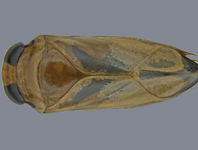Abstract
Microlaimus sergeevae sp. n. is described and illustrated from the Crimea shelf of the Black Sea. It is characterized by the 1301–1728 μm long body; cuticle with distinct annuli; spicules 34–37 μm long, curved; gubernacular apophyses 20–25 μm long, surrounding distal end of spicules; criptocyrcular amphidial fovea 7–8 μm in diameter; cervical setae present; four submedian rows of pores spreading along the whole body length, and eight precloacal supplements in males. The new species morphologically resembles M. gerlachi Wieser 1954, M. paraborealis Allgen 1940a and M. kaurii Wieser 1954, but differs from them by the length of cephalic setae, size of the body, presence of cervical setae, shape of the gubernacular apophyses, eight tubular precloacal supplements and submedian rows of pores spreading along the whole body length. M. sergeevae sp. n. differs from M. gerlachi by having a smaller amphidial fovea, shorter spicules and gubernacular apophyses. The new species differs from M. paraborealis by having larger value of c. It differs from M. kaurii by having longer spicules and larger values of c and b.
References
Al-Sofyani, A. & El-Sherbiny, M. (2018) Meiobenthic assemblage of the grey mangrove (Avicennia marina) along the Saudi Arabian coast of the Red Sea with emphasis on free-living nematodes. Oceanological and Hydrobiological Studies, 47 (4), 359–375.
https://doi.org/10.1515/ohs-2018-0034
Bezerra, T.N., Decraemer, W., Eisendle-Flöckner, U., Hodda, M., Holovachov, O., Leduc, D., Miljutin, D., Mokievsky, V., Peña Santiago, R., Sharma, J., Smol, N., Tchesunov, A., Venekey, V., Zhao, Z. & Vanreusel, A. (2019) Nemys: World Database of Nematodes. Available from: http://nemys.ugent (accessed 2 September 2019)
Chen, Y., Guo, Y. & Liu, A. (2019) Community structures of free-living marine nematodes on sandy beach of Changjiangao (Haitan Island, Fujian Province). Acta Ecologica Sinica, 39 (7), 2573–2582.
https://doi.org/10.5846/stxb201801220173
Gallucci, F., Moens, T. & Fonseca, G. (2009) Small-scale spatial patterns of meiobenthos in the Arctic deep sea. Marine Biodiversity, 39, 9–25.
https://doi.org/10.1007/s12526-009-0003-x
Giere, O. (2009) Meiobenthology. The microscopic motile fauna of aquatic sediments. 2nd Edition. Springer, Berlin Heidelberg, 527 pp.
Hasemann, C.& Soltwedel, T. (2011) Small-Scale Heterogeneity in Deep-Sea Nematode Communities around Biogenic Structures. PLoS One, 6 (12), e29152.
https://doi.org/10.1371/journal.pone.0029152
Kozlovskiy, V.V., Chikina, M.V., Shabalin, N.V., Basin, A.B., Mokievskiy, V.O. & Kucheruk, N.V. (2019) Spatial Structure of Macro- and Meiobenthic Communities in a Homogeneous Environment (on the Example of the Pechora Sea). Oceanology, 59 (3), 367–373.
https://doi.org/10.1134/S000143701903010X
Liu, X.S., Zhang, Z.N. & Huang, Y. (2007) Sublittoral meiofauna with particular reference to nematodes in the southern Yellow Sea, China. Estuarine, Coastal and Shelf Science, 71 (3–4), 616–628.
https://doi.org/10.1016/j.ecss.2006.09.013
Revkova, T.N. (2017) Two new species of free-living nematodes genera Microlaimus de Man, 1880 and Aponema Jensen, 1978 (Nematoda: Microlaimidae) from the Black Sea. Zootaxa, 4344 (2), 387–394.
https://doi.org/10.11646/zootaxa. 4344.2.13
Revkova, T.N. (2017) First records of Microlaimus tenuispiculum de Man, 1922 (Nematoda: Microlaimidae) from the Black Sea. Ecologica Montenegrina, 14, 74–79.
Semprucci, F., Colantoni, P., Baldelli, G., Sbrocca, C., Rocchi, M. & Balsamo, M. (2013) Meiofauna associated with coral sediments in the Maldivian subtidal habitats (Indian Ocean). Marine Biodiversity, 43, 189–198.
https://doi.org/10.1007/s12526-013-0146-7
Sergeeva, N.G., Gooday, A.J., Mazlumyan, S.A., Kolesnikova, E.A., Lichtschlag, A., Kosheleva, T.N. & Anikeeva, O.V. (2012) Meiobenthos of the oxic/anoxic interface in the Southwestern region of the Black Sea: abundance and taxonomic composition. In: Altenbach, A.V., Bernhard, J.M. & Seckbach, J. (Eds.), Anoxia: paleontological strategies and evidence for eukaryotes Survival. Springer, Dordrecht, pp. 369–401.
https://doi.org/10.1007/978-94-007-1896-8_20
Sergeeva, N.G. (2003) Meiobenthos of area with methane gas seeps. In: Eremeev, V.N. & Gaevskaya, A.V. (Eds.), Modern condition of biological diversity in near-shore zone of the Crimea (the Black Sea sector). Ekosi-Gidrophizika, Sevastopol, pp. 258–267.
Tchesunov, A.V. (2014) Order Desmodorida De Coninck, 1965. In: Schmidt-Rhaesa, A. (Ed.), Handbook of Zoology. Gastrotricha, Cycloneuralia, Gnathifera. Vol. 2. Nematoda. De Gruyter, Hamburg, pp. 399–434.
Tsalolikhin, S. Ya. (1980) Free-Living Nematodes of Lake Baikal. Nauka, Novosibirsk, 119 pp.
Wieser, W. (1954) Free-living marine nematodes. II. Chromadoroidea. Acta Universitatis Lundensis, Neue Folge, 2), 50 (16), 1–148.
Zaika, V.E., Ivanova, Е.А. & Sergeeva, N.G. (2011) Seasonal changes of meiobenthos of the Sevastopol Bays with the analysis of influence of bottom hypoxia. Marine Ecological Journal, Special Issue 2, 29–36.

